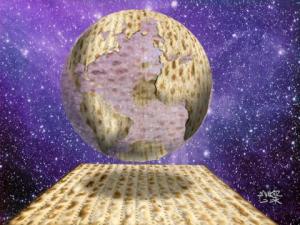
Seder means Order. Passover Seders follow an order of 14 Steps. I won’t list them all here but I will ask you to notice the relationship between Step 4,Yachatz, and Step 11, Tzafun.
Yachatz is about being broken; the bitterness of slavery, the Red Sea splitting. It is symbolized during the Seder by breaking matzah (the unrisen bread) and then hiding the bigger half. Tzafun is about healing the brokenness; bringing the broken-off part out from hiding. It’s about healing into something new; coming into wholeness. At the Seder, it is symbolized by the search for the broken half which, once found, is broken into smaller pieces so that all who are at the table may eat of it.
Why does Yachatz/the broken become Tzafun/the whole? How does this happen? In addition to Passover telling a story about transformation from yachatz/the brokenness of slavery to tzafun/the wholeness of freedom, here are two more examples from Jewish history.
(1) During Biblical times, Jews made the pilgrimage to the one and only Holy Temple for major festivals. It was the center of all religious life. When the Temple was destroyed (yachatz), so was a way of life. But the destruction made space for a new way of life/a new consciousness that was needed to meet the changing times. Rabbinic Judaism (tzafun) repurposed the previous form of religion. Synagogues replaced the Temple and rabbis replaced the High Priest. A new way of expressing Judaism formed.
(2) The biblical story of God’s preference for Abel’s sacrifice (sheep) over his brother Cain’s sacrifice (vegetables) may not have been about offering one’s best, but about letting it go. Howard Adelman, who taught me Hegel’s philosophy, shared an interesting perspective when he wrote, “God preferred to recognize the nomadic way of life of the shepherd even as humanity was adopting to a sedentary agricultural way of life. The irony is that God’s recognition was not for that which was to be valued as historically the superior way of life, but as the way of life that had to be sacrificed to give way to agricultural societies.”
If slavery made way for freedom, if the destruction of the Holy Temple made room for rabbinic Judaism, and if the declining pastoral life allowed for agrarian society, then what is the Yachatz of today? And for what is our evolution calling? You might discuss these questions and your answers during Passover. But please, do so with optimism for the new and patience for the process since, after all, there are seven steps between yachatz and tzafun (with tzafun being the Shabbat step in this series).
My short answer: Yachatz/Broken is the post-modern stage of consciousness and the forms within it including Judaism and organized religions as we know them. This is not to say that the values of postmodernism aren’t necessary. They are critical; we cannot get to the next stage without them. Tzafun/Coming into wholeness points to a new perspective in the evolution of culture. Today’s version of religion will be repurposed, perhaps modeled after spiritually independent families’ responses to pluralism. Just as it takes time to get from Step 4 (yachatz) to Step 11 (tzafun) during the seder, it takes time to spiral from one vantage point to the next. But in doing so, a worldview through which we become capable -by our own free will- to solve the unanswered problems of the day takes shape. Not only will everyone at the table taste a piece of Passover…they might also taste the peace of Passover.
I invite you to see my Resources for ideas on holidays, lessons, social justice and more.
Leave a Reply